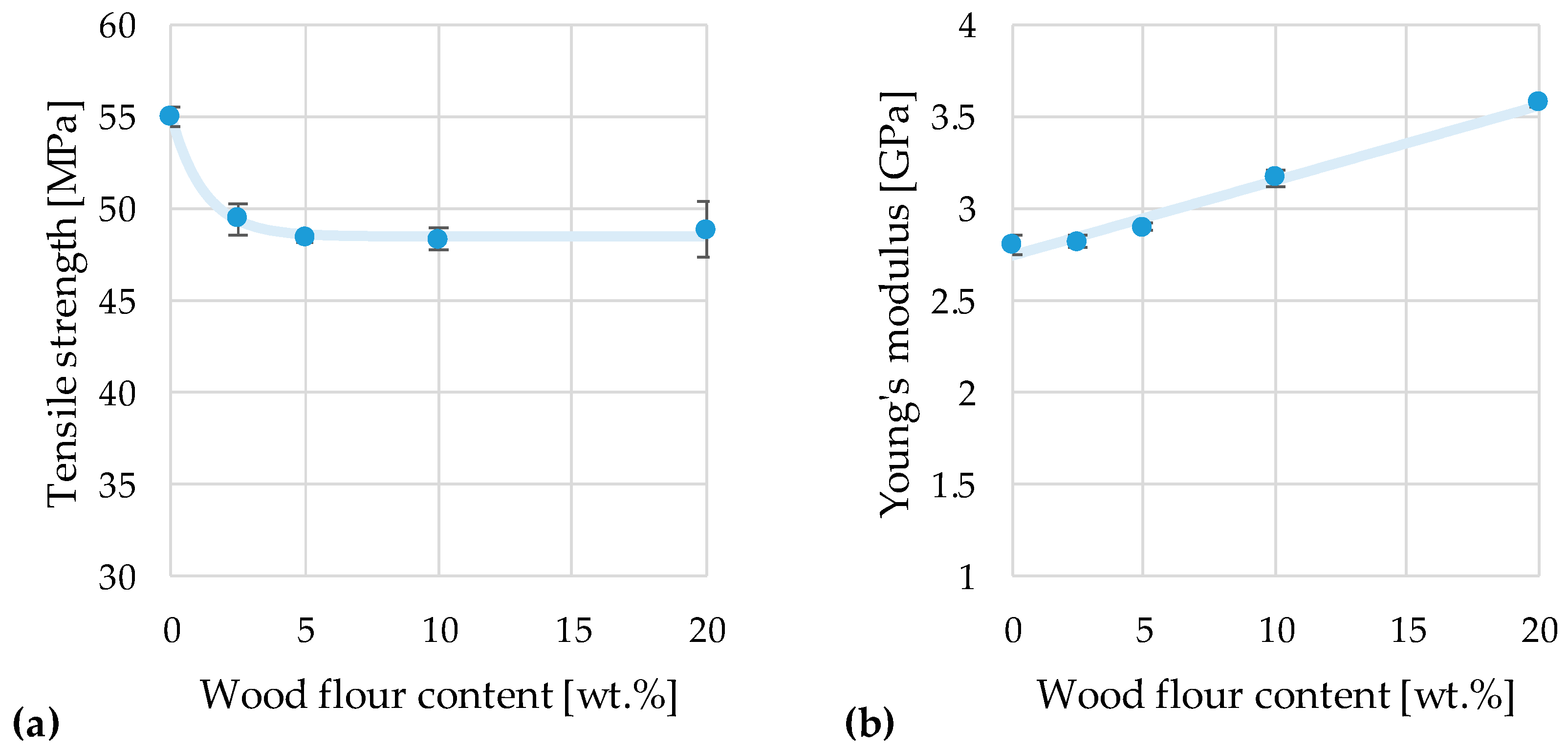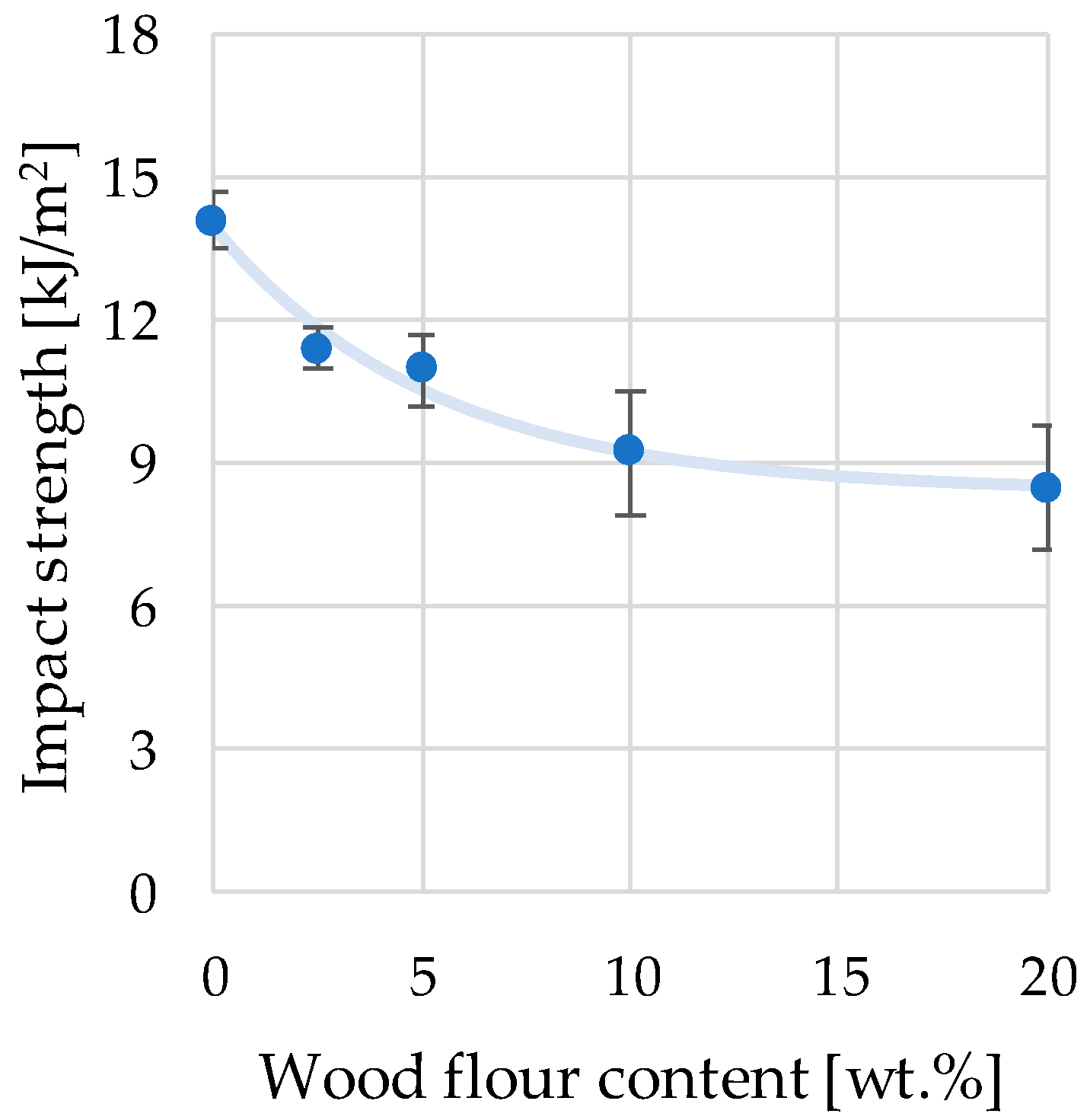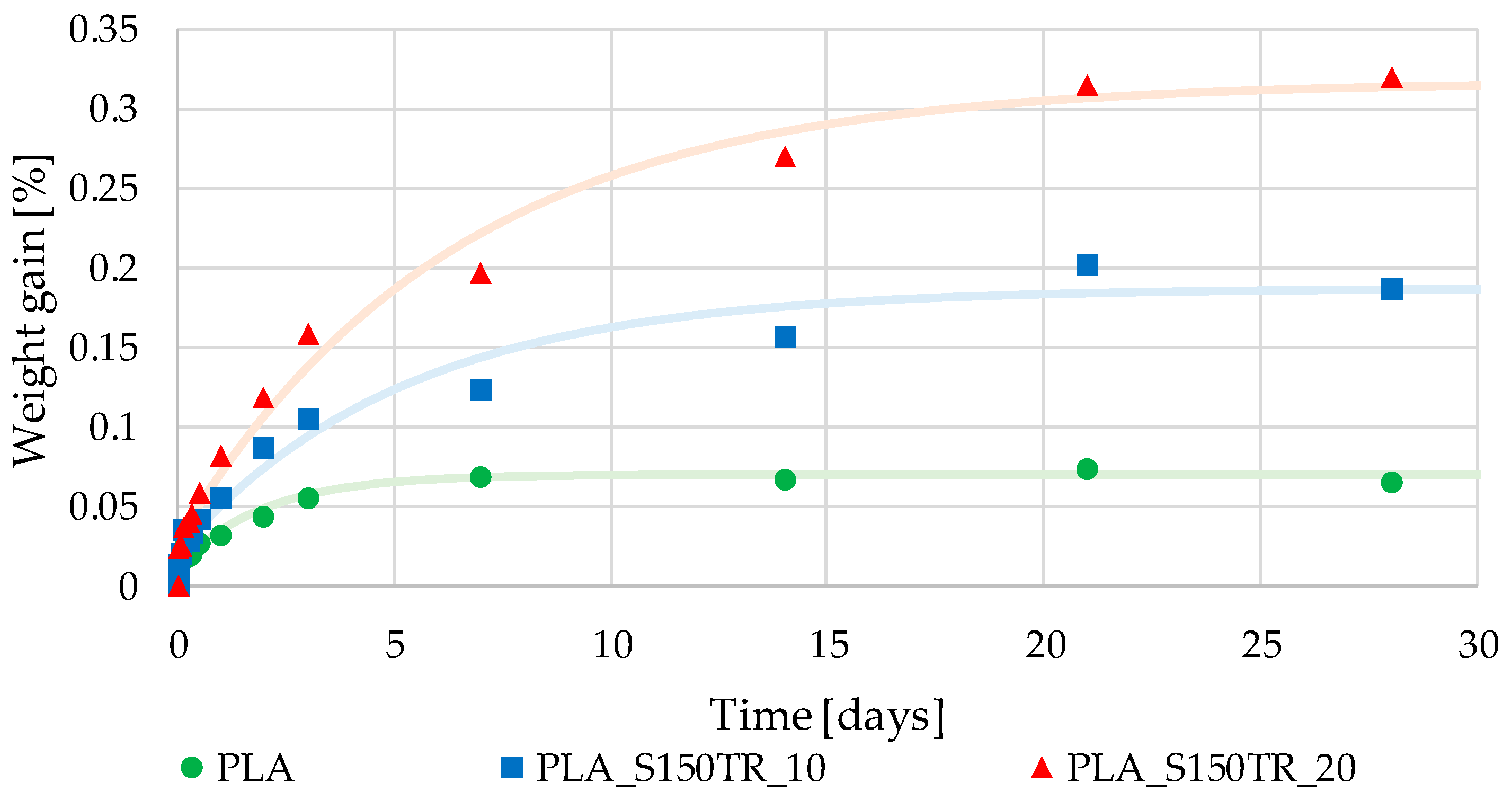The Effect of Wood Flour Incorporation on the Properties of Injection Molded Poly(Lactic Acid) Products †
Abstract
1. Introduction
2. Materials and Methods
2.1. Materials and Processing Techniques
2.2. Characterization
3. Results and Discussion
3.1. Tensile Tests
3.2. Impact Tests
3.3. Water Absorption Tests
4. Conclusions
- The incorporation of WF effectively improves the modulus of PLA; however, this comes at the cost of strength (both tensile and impact), which decreases with growing WF content.
- Biocomposites exhibit more hydrophilic behavior than neat PLA, which, along with the potential gaps and voids on the interphase of the components, result in a higher water absorption.
Author Contributions
Funding
Institutional Review Board Statement
Informed Consent Statement
Data Availability Statement
Acknowledgments
Conflicts of Interest
References
- Korley, L.T.J.; Epps, T.H.; Helms, B.A.; Ryan, A.J. Toward polymer upcycling—Adding value and tackling circularity. Science 2021, 373, 66–69. [Google Scholar] [CrossRef]
- Steinhorst, J.; Beyerl, K. First reduce and reuse, then recycle! Enabling consumers to tackle the plastic crisis—Qualitative expert interviews in Germany. J. Clean. Prod. 2021, 313, 127782. [Google Scholar] [CrossRef]
- Shlush, E.; Davidovich-Pinhas, M. Bioplastics for food packaging. Trends Food Sci. Technol. 2022, 125, 66–80. [Google Scholar] [CrossRef]
- Shaikh, S.; Yaqoob, M.; Aggarwal, P. An overview of biodegradable packaging in food industry. Curr. Res. Food Sci. 2021, 4, 503–520. [Google Scholar] [CrossRef] [PubMed]
- Backes, E.H.; Harb, S.V.; Beatrice, C.A.G.; Shimomura, K.M.B.; Passador, F.R.; Costa, L.C.; Pessan, L.A. Polycaprolactone usage in additive manufacturing strategies for tissue engineering applications: A review. J. Biomed. Mater. Res. B Appl. Biomater. 2022, 110, 1479–1503. [Google Scholar] [CrossRef]
- Popa, M.S.; Frone, A.N.; Panaitescu, D.M. Polyhydroxybutyrate blends: A solution for biodegradable packaging? Int. J. Biol. Macromol. 2022, 207, 263–277. [Google Scholar] [CrossRef] [PubMed]
- Coppola, G.; Gaudio, M.T.; Lopresto, C.G.; Calabro, V.; Curcio, S.; Chakraborty, S. Bioplastic from Renewable Biomass: A Facile Solution for a Greener Environment. Earth Syst. Environ. 2021, 5, 231–251. [Google Scholar] [CrossRef]
- Goel, V.; Luthra, P.; Kapur, G.S.; Ramakumar, S.S.V. Biodegradable/Bio-plastics: Myths and Realities. J. Polym. Environ. 2021, 29, 3079–3104. [Google Scholar] [CrossRef]
- Kim, J.; Kim, Y.M.; Lebaka, V.R.; Wee, Y.J. Lactic Acid for Green Chemical Industry: Recent Advances in and Future Prospects for Production Technology, Recovery, and Applications. Fermentation 2022, 8, 609. [Google Scholar] [CrossRef]
- Yu, J.; Xu, S.; Liu, B.; Wang, H.; Qiao, F.; Ren, X.; Wei, Q. PLA bioplastic production: From monomer to the polymer. Eur. Polym. J. 2023, 193, 112076. [Google Scholar] [CrossRef]
- Grillo, A.; Rusconi, Y.; Alterio, M.C.; De Rosa, C.; Talarico, G.; Poater, A. Ring Opening Polymerization of Six- and Eight-Membered Racemic Cyclic Esters for Biodegradable Materials. Int. J. Mol. Sci. 2024, 25, 1647. [Google Scholar] [CrossRef] [PubMed]
- Shekhar, N.; Mondal, A. Synthesis, properties, environmental degradation, processing, and applications of Polylactic Acid (PLA): An overview. Polym. Bull. 2024, 81, 11421–11457. [Google Scholar] [CrossRef]
- Nirmal Kumar, K.; Dinesh Babu, P. Experimental study of mechanical, morphological and thermal performance of bamboo-reinforced polylactic acid-based montmorillonite clay hybrid composite. Ind. Crops Prod. 2024, 209, 117950. [Google Scholar] [CrossRef]
- Sun, Y.; Wang, Y.; Mu, W.; Zheng, Z.; Yang, B.; Wang, J.; Zhang, R.; Zhou, K.; Chen, L.; Ying, J.; et al. Mechanical properties of 3D printed micro-nano rice husk/polylactic acid filaments. J. Appl. Polym. Sci. 2022, 139, e52619. [Google Scholar] [CrossRef]
- Yu, W.; Sun, L.; Li, M.; Peng, Y.; Wei, C.; Lei, W.; Qiu, R.; Ge, Y. Effect of Modification and Hydrothermal Ageing on Properties of 3D-Printed Wood Flour–Poly(butylene succinate)–Poly(lactic acid) Biocomposites. Polymers 2023, 15, 3697. [Google Scholar] [CrossRef] [PubMed]
- Jakab, S.K.; Singh, T.; Fekete, I.; Lendvai, L. Agricultural by-product filled poly(lactic acid) biocomposites with enhanced biodegradability: The effect of flax seed meal and rapeseed straw. Compos. C Open Access 2024, 14, 100464. [Google Scholar] [CrossRef]
- ISO 527-2; Plastics—Determination of Tensile Properties, Part 2: Test Conditions for Moulding and Extrusion Plastics. ISO: Geneva, Switzerland, 2012.
- ISO 527-1; Plastics—Determination of Tensile Properties, Part 1: General principles. ISO: Geneva, Switzerland, 2019.
- ISO 179-1; Plastics—Determination of Charpy Impact Properties, Part 1: Non-Instrumented Impact Test. ISO: Geneva, Switzerland, 2023.
- Mohammed, M.; Rasidi, M.S.M.; Mohammed, A.; Rahman, R.; Osman, A.; Adam, T.; Betar, B.; Dahham, O. Interfacial bonding mechanisms of natural fibre-matrix composites: An overview. Bioresources 2022, 17, 7031–7090. [Google Scholar] [CrossRef]
- Kannan, G.; Thangaraju, R.; Kayaroganam, P.; Davim, J.P. The Combined Effect of Banana Fiber and Fly Ash Reinforcements on the Mechanical Behavior of Polyester Composites. J. Nat. Fibers 2022, 19, 11384–11403. [Google Scholar] [CrossRef]
- Lendvai, L.; Patnaik, A. The effect of coupling agent on the mechanical properties of injection molded polypropylene/wheat straw composites. Acta Tech. Jaurinensis 2022, 15, 232–238. [Google Scholar] [CrossRef]
- Kuciel, S.; Mazur, K.; Hebda, M. The Influence of Wood and Basalt Fibres on Mechanical, Thermal and Hydrothermal Properties of PLA Composites. J. Polym. Environ. 2020, 28, 1204–1215. [Google Scholar] [CrossRef]
- Al Abdallah, H.; Abu-Jdayil, B.; Iqbal, M.Z. Improvement of mechanical properties and water resistance of bio-based thermal insulation material via silane treatment. J. Clean. Prod. 2022, 346, 131242. [Google Scholar] [CrossRef]
- Ratna Kumari, Y.; Ramanaiah, K.; Ratna Prasad, A.V.; Hemachandra Reddy, K.; Prasad Sanaka, S.; Kalyan Prudhvi, A. Experimental investigation of water absorption behaviour of sisal fiber reinforced polyester and sisal fiber reinforced poly lactic acid composites. Mater. Today Proc. 2021, 44, 935–940. [Google Scholar] [CrossRef]



| Designation | PLA [wt.%] | Wood Flour [wt.%] |
|---|---|---|
| PLA | 100 | 0 |
| PLA_S150TR_2.5 | 97.5 | 2.5 |
| PLA_S150TR_5 | 95 | 5 |
| PLA_S150TR_10 | 90 | 10 |
| PLA_S150TR_20 | 80 | 20 |
| Parameter [unit] | Value |
|---|---|
| Screw diameter [mm] | 35 |
| Nozzle temperature [°C] | 195 |
| Injection rate [cm3/s] | 40 |
| Holding pressure [bar] | 750–650–250 |
| Mold temperature [°C] | 30 |
Disclaimer/Publisher’s Note: The statements, opinions and data contained in all publications are solely those of the individual author(s) and contributor(s) and not of MDPI and/or the editor(s). MDPI and/or the editor(s) disclaim responsibility for any injury to people or property resulting from any ideas, methods, instructions or products referred to in the content. |
© 2024 by the authors. Licensee MDPI, Basel, Switzerland. This article is an open access article distributed under the terms and conditions of the Creative Commons Attribution (CC BY) license (https://creativecommons.org/licenses/by/4.0/).
Share and Cite
Jakab, S.K.; Bódi, V.L.; Lendvai, L. The Effect of Wood Flour Incorporation on the Properties of Injection Molded Poly(Lactic Acid) Products. Eng. Proc. 2024, 79, 43. https://doi.org/10.3390/engproc2024079043
Jakab SK, Bódi VL, Lendvai L. The Effect of Wood Flour Incorporation on the Properties of Injection Molded Poly(Lactic Acid) Products. Engineering Proceedings. 2024; 79(1):43. https://doi.org/10.3390/engproc2024079043
Chicago/Turabian StyleJakab, Sándor Kálmán, Virág Luca Bódi, and László Lendvai. 2024. "The Effect of Wood Flour Incorporation on the Properties of Injection Molded Poly(Lactic Acid) Products" Engineering Proceedings 79, no. 1: 43. https://doi.org/10.3390/engproc2024079043
APA StyleJakab, S. K., Bódi, V. L., & Lendvai, L. (2024). The Effect of Wood Flour Incorporation on the Properties of Injection Molded Poly(Lactic Acid) Products. Engineering Proceedings, 79(1), 43. https://doi.org/10.3390/engproc2024079043







